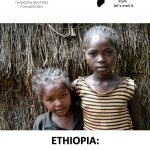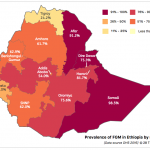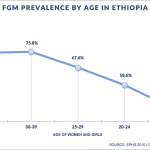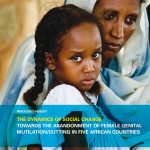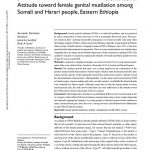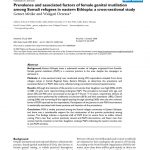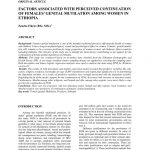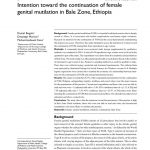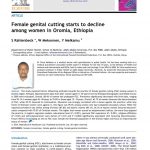Ethiopia

- Australia
- Benin
- Brunei
- Burkina Faso
- Cameroon
- Canada
- Central African Republic
- Chad
- Colombia
- Côte d’Ivoire (Ivory Coast)
- Denmark
- Djibouti
- Egypt
- Eritrea
- Ethiopia
- France
- Germany
- Ghana
- Guinea
- Guinea-Bissau
- Indonesia
- India
- Iran
- Iraq
- Ireland
- Jordan
- Kenya
- Kuwait
- Liberia
- Malawi
- Malaysia
- Mali
- Malta
- Mauritania
- Mexico
- Niger
- Nigeria
- Oman
- Pakistan
- Peru
- Portugal
- Russia
- Saudi Arabia
- Senegal
- Sierra Leone
- Singapore
- Somalia
- Somaliland
- South Sudan
- Spain
- Sudan
- Sweden
- Switzerland
- Tanzania
- Thailand
- The Gambia
- The Maldives
- Togo
- Uganda
- United Arab Emirates
- United Kingdom
- United States of America
- Yemen
- Zambia
- Zimbabwe
Population
108.1 million
Estimated prevalence among girls and women aged 15-49
65%
2018 population growth rate
2.46%
Estimated prevalence among girls and women aged 15-19
47%
Type practised
The most widely practised forms of female genital cutting (FGC) in Ethiopia are Type I and II. Type varies according to ethnic group, with Type III common in areas bordering Sudan and Somalia.
Age
Girls in Ethiopia undergo FGC throughout childhood. Half of girls and women aged 15-49 underwent FGC before they reached the age of five (49%) while 22% underwent FGC between the ages of five and nine.
Source: UNFPA-UNICEF
Agent
FGC in Ethiopia is performed by traditional practitioners. They account for 98% of FGC cases among girls aged 0-14.
Source: UNFPA-UNICEF
Legal status
Illegal. Legislation banning FGC was brought in in 2004, although prosecutions are rare.
Source: UNFPA-UNICEF
National progress
- 2005 – The legal provision to criminalise FGC was introduced
- 2012 – The National Alliance to End FGM and Child Marriage was established
- 2013 – National Strategy and Action Plan on Harmful Traditional Practices was endorsed
- 2014 – Articulation of a national vision to end FGC and child marriage by 2025 was rolled out
- 2016 – Ethiopia’s Second Growth and Transformation Plan (2015/16-2019/20) reflected national commitment to address FGC
- National Adolescent and Youth Health Strategy (2016-2020) articulating a focus on FGC released
- 2018 – At the European Development Days 2018, Demitu Hambisa Bonsa, Chief of the Staff of the Cabinet and Prime Minister’s Office shared a commitment to reducing prevalence to 0.5% by 2025.
UN programme
The UNFPA-UNICEF Joint Programme interventions are located in two regions of the country where prevalence rates are highest: Afar and Southern Nations, Nationalities and Peoples’ Region (SNNPR). In the second phase of this programme (2014-2017), 11,851 communities made public declarations of FGC abandonment involving more than 900,000 individuals. The UN reports that the vast majority of girls and women, as well as boys and men, think FGC should end. The lower prevalence among younger women suggests that the practice is declining.
Source: UNFPA-UNICEF
Enforcement
Public information is limited. Although the number of arrests have increased, very few FGC cases appear to proceed to court in Ethiopia. More often, cases would seem to be handled through local, traditional justice systems.
Source: 28 Too Many
Human Development Index ranking
173 in 2018 index, based on 2017 data.
Infant mortality rate
41 deaths per 1,000 live births (2015).
Source: 28 Too Many
Maternal mortality rate
353 deaths per 100,000 live births (2015).
Source: 28 Too Many
Trends in FGC prevalence
The practice of FGC in Ethiopia is changing. 47% of girls aged 15-19 have undergone FGC procedures compared to 75% of women aged 35-49.
Source: UNFPA-UNICEF
Prevalence breakdown
By region
Although FGC is practised across Ethiopia, it is particularly prevalent in two areas: The SNNPR and Afar, where the prevalence rate is 91%.
Source: UNFPA-UNICEF
Practising ethnic groups
Ethnicity is a major factor. The practice of FGC is non-existent among certain ethnic groups and universal in others, such as the Amhara, Tigrayan, Gurage, Oromo, Shalink, Afar, Somali and Harari.
Source: UNICEF and UNFPA-UNICEF

